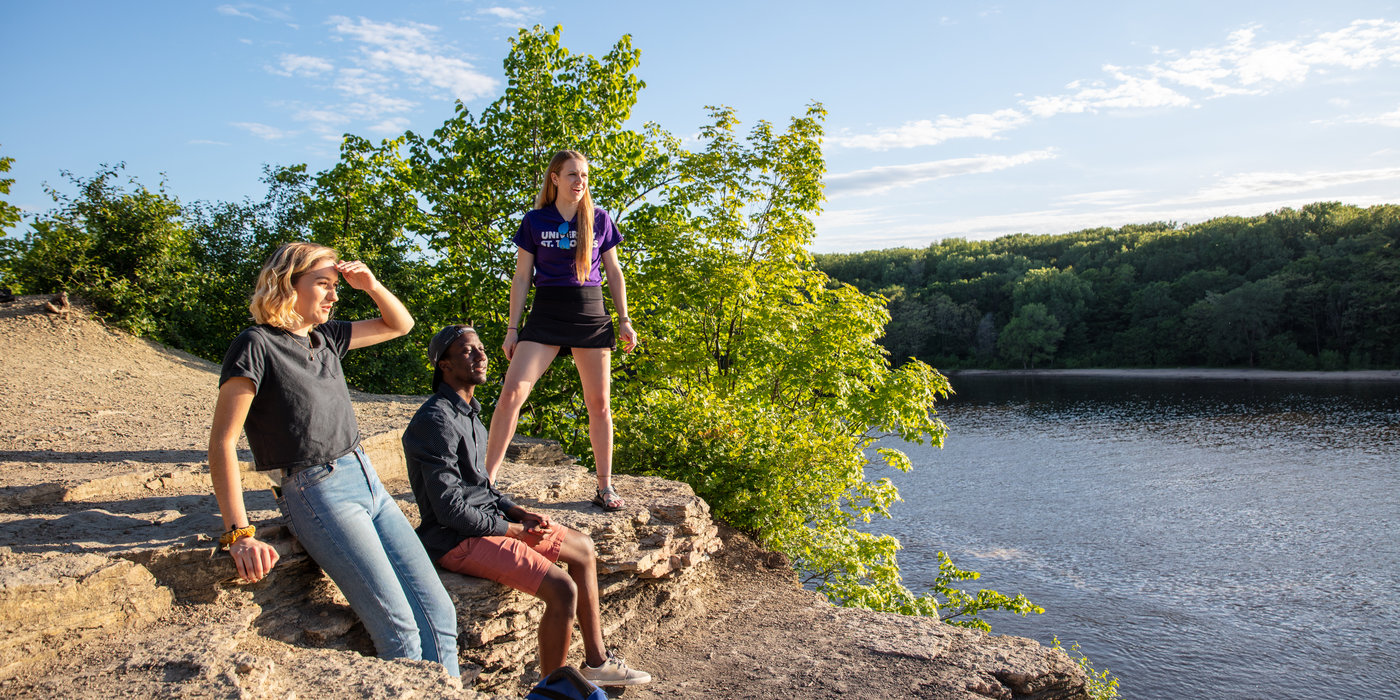For the first time, St. Thomas has a comprehensive strategic plan for sustainability.
The plan is the result of 18 months of assessment, community engagement and work group discussions to identify a vision, goals and concrete action steps the university can pursue to advance its commitment to sustainability. Click here to view the entire plan.

Students Sarah Benoy, Shukrani Nangwala and Mackenzie Stahl talk in Shadow Falls Park in St. Paul. (Mark Brown/University of St. Thomas)
“The plan represents the commitment of our entire university to lead and achieve in environmental stewardship and caring for God’s creation – areas at the core of our mission to advance the common good,” President Julie Sullivan said.
In 2008, St. Thomas’ then-President Father Dennis Dease signed the American College and University Presidents’ Climate Commitment, and the Board of Trustees adopted a strategic priority on environmental stewardship and sustainability. Since then, St. Thomas students, faculty and staff have championed many initiatives to infuse sustainability into the university’s academic programs, co-curricular activities and operations.
Building on that foundation, the current plan centers on the vision, “By catalyzing university-wide engagement, we will create a culture that prepares students to be sustainability leaders during their university years and beyond,” and outlines two main goals of achieving a Sustainability Tracking, Assessment and Rating System (STARS) gold rating by 2025 (St. Thomas received a silver rating in 2018) and achieving carbon neutrality by 2035.
“The plan gives us a coordinated, strategic approach, and a sense of how how sustainability fits into what we all do every day,” said Amir Nadav, assistant director of campus sustainability. “As an educational institution, one of the most valuable things we can do is educate students to be sustainability leaders. … To achieve that vision, sustainability needs to be part of the culture, something we can model and participate in all the time. The plan draws on principles and values that are core to the identity of the institution, and demonstrates how sustainability is part of our mission to advance the common good.”
“I would like to express my deep gratitude to the many students, faculty, staff and alumni who have worked together to create this plan. Nearly 1,500 individuals engaged in the planning process through class projects, a community visioning brainstorm, a strategic plan workshop and nine work groups. This collective effort resulted in a plan to infuse sustainability throughout the academic, cocurricular, administrative and operational functions of our university,” Sullivan said. “I look forward to seeing this plan grow as we continue to put our minds, ideas, strategies and initiatives to work for sustainability.”
Big plan, individual efforts
Creating a sustainability strategic plan specific to St. Thomas allowed everyone involved to understand and build on what makes this university and its community unique.
“Our understanding of, and commitment to, sustainability is grounded in our identity as a Catholic university,” the plan states. “This plan embraces the principles of caring for creation, environmental stewardship and advancing the common good. These beliefs encompass a concern for social equity, economic prosperity and the healthy functioning of ecological systems both now and in the future. By implementing this plan, we aim to model sustainability in our own practices and to educate students who will improve lives today and build a better world for future generations.”
The plan’s scope is wide and far-reaching, encompassing every aspect of St. Thomas: from the mission, to student and employee engagement; academics; sustainable investments; transportation; dining services; facilities management; and procurement. Underlying everything is the desire to create a culture where every single St. Thomas community member contributes to sustainability in their everyday lives.
“This isn’t a pie in the sky set of aspirations,” Nadav said. “This is a very tangible set of actions we can accomplish over the next five years as everyone at St. Thomas contributes.”







